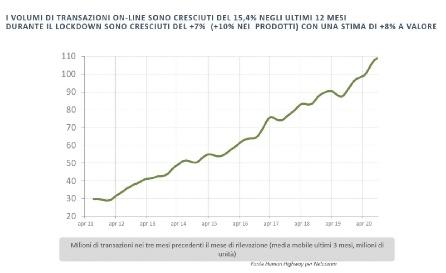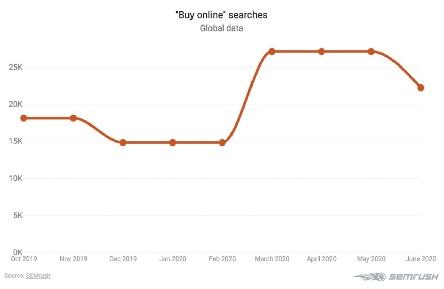
9 minute read
La digitalizzazione continua a cambiare il retail
from Foto Shoe 30 2021-01
by edizioniaf
DIGITISATION CONTINUES TO CHANGE RETAIL
I dati non fanno che confermare l’ascesa del commercio digitale, di cui acconta anche Federico Marchetti, patron di Yoox-Net à porter. Data do nothing but confirm the rise of digital commerce, as also Federico Marchetti, owner of Yoox-Net à porter points out.
Secondo il report presentato da Netcomm, realizzato in collaborazione con The European House – Ambrosetti e che ha indagato “Il ruolo e il contributo dell’e-commerce e del digital retail alla crescita e alla trasformazione digitale”, la rete del valore dell’e-commerce è al terzo posto tra le 99 attività economiche italiane per incidenza sul fatturato del settore privato in Italia nel 2019, con un peso del 19,2% sulla crescita di fatturato del totale delle attività economiche italiane. Nello stesso anno, inoltre, la rete ha inciso profondamente sulla crescita dell’occupazione delle imprese italiane, con un contributo del 6,7% sul totale. Il settore legato agli acquisti online in Italia nel 2020 genera un incremento di ricavi per 3,5 miliardi di euro (+6,3% sul 2019, un trend decisamente più contenuto rispetto al tasso medio del +18% degli ultimi 5 anni). Inoltre, l’e-commerce è stato uno dei settori che ha incrementato di più il proprio peso relativo sul fatturato complessivo delle imprese italiane con una crescita del 19,2%. Un successo che SEMrush, piattaforma di Saas per la gestione della visibilità on line, ha riscontrato anche a livello internazionale durante la raccolta e l’analisi dei dati di oltre 2.000 siti di e-commerce. Dall’inizio del 2020 all’ottobre dello stesso anno, le ricerche sui negozi online sono aumentate costantemente di mese in mese, con una media del 36% per tutti i settori merceologici. L’incremento magAccording to the report presented by Netcomm, produced in collaboration with The European House - Ambrosetti and which investigated “The role and contribution of e-commerce and digital retail to digital growth and transformation”, the value network of e-commerce ranks third among the 99 Italian economic activities for incidence on turnover of the private sector in Italy in 2019, with a weight of 19.2% on the growth in turnover of total Italian economic activities. Moreover, in the same year, the web had a profound impact on the employment growth of Italian companies, contributing 6.7% of the total. The sector connected to online purchases in Italy in 2020 generates an increase in revenues of 3.5 billion euro (+6.3% compared to 2019, a much more contained trend than the average rate of +18% in the last 5 years). Furthermore, e-commerce has been one of the sectors that has increased its relative weight on the total turnover of Italian companies with a growth of 19.2%. A success that SEMrush, the Saas platform that manages online visibility, also found internationally when collecting and analysing data relating to over 2,000 e-commerce websites. From early 2020 to October of the same year, online store searches steadily increased every month, with an average of 36% for all product sectors. The largest increase compared to the previous month

Volumi di transazioni online da aprile 2019 ad aprile 2020 Volumes of online transactions from April 2019 to April 2020

giore rispetto al mese precedente si è avuto a marzo, con l’inizio del lockdown, che ha segnato all’incirca un raddoppio dei volumi. Circa il 70% degli utenti si è connesso da smartphone, sapendo già dove acquistare. Un dato particolarmente indicativo del ruolo che ricopre il brand e l’importanza di una reputazione solida per fidelizzare i clienti nello shopping online. Tutti dati che confermano quanto la digitalizzazione del commercio stia profondamente cambiando il panorama distributivo. Un altro esempio: il gruppo H&M ha ottenuto un tale boom online che si è convinta ad operare un netto taglio di negozi nel 2021 (circa 180). Le vendite digitali sono aumentate del 28% nel terzo trimestre 2020, mentre nei nove mesi sono cresciute del 34%, andando così a rappresentare il 26% del totale delle vendite del gruppo. Sottolinea i mutamenti in atto anche Stefano Portu, ad e fondatore di ShopFully: “Il settore retail sta vivendo un momento di cambiamento epocale: nei mesi appena trascorsi abbiamo visto accelerare fortemente la digitalizzazione già in atto da tempo, con lo smartphone che diventa il mezzo chiave per accompagnare il consumatore in negozio. Questa rivoluzione nelle strategie dei retailer italiani e internazionali non accenna a rallentare: sia i consumatori, sia i retailer confermano di aver scelto lo smartphone come primo canale di relazione e comunicazione, superando anche mezzi tradizionali.” occurred in March, with the start of the lockdown, which roughly doubled volumes. About 70% of users connected from smartphones, already knowing where to buy. A figure that is particularly indicative of the role that the brand plays and the importance of a solid reputation for retaining customers in online shopping. All these data confirm how much the digitalisation of commerce is profoundly changing the panorama of distribution. Another example: the H&M group has achieved such an online boom that it declared itself convinced to cut (about 180) stores in 2021. Digital sales increased by 28% in the third quarter of 2020, and grew by 34% in nine months, thus accounting for 26% of the group’s total sales. Also, Stefano Portu, CEO and founder of ShopFully, highlights the changes: “The retail sector is experiencing a moment of epochal change: in these passed months, we have seen digitisation already underway for some time accelerating strongly, while the smartphone is assuming a key role to accompany the consumer to the store. This revolution in the strategies of Italian and international retailers shows no signs of slowing down: both consumers and retailers confirm that they have chosen the smartphone as the first channel of relationship and communication, overcoming even traditional means”.
FEDERICO MARCHETTI E IL DIGITALE SOSTENIBILE FEDERICO MARCHETTI AND SUSTAINABLE DIGITAL
Non poteva che confermare bontà ed evoluzioni della digitalizzazione del commercio anche Federico Marchetti, presidente e ceo di Yoox-Net à porter, intervenuto alla Milano Fashion Global Summit 2020. “Come e-tailer abbiamo investito di recente sul progetto Infinity 2030, una nuova strategia che si articola in dodici impegni strettamente legati ai sustainable development goals dell’Onu. Il raggiungimento dei primi obiettivi è previsto per la fine del 2020 e rappresenterà la base su cui portare avanti un cambiamento che avverrà nel corso del prossimo decennio”. Il lancio della strategia Infinity segue quello della collezione sostenibile Yook net-a-porter for The Prince’s Foundation, frutto del progetto The Modern Artisan. Iniziativa che ha avuto come obiettivo il rafforzare le competenze tessili di giovani artigiani nel Regno Unito e in Italia per creare capi di lusso sostenibili. “Trovare la giusta combinazione fra creatività umana e tecnologia, questo è da sempre il mio scopo – ha proseguito Marchetti -. Perciò abbiamo messo al centro del progetto sia i big data raccolti in 20 anni di attività, sia dei giovani artigiani. L’analisi dei dati e l’impiego dell’intelligenza artificiale agevolano la riduzione degli sprechi, l’uso consapevole dei materiali e la conseguente longevità dei capi”. Quanto sono big i big data di Yoox-Net à porter? Circa 4,3 milioni di clienti attivi, oltre 2 miliardi di fatturato, 36 milioni di fotografie perfettamente archiviate e metadatate che possono essere consultate e interrogate con filtri e sistemi di analisi. “Siamo in grado di fornire un amplissimo spettro di informazioni alla creatività e aiutarla così a centrare il prodotto giusto per la vendita. Mi immagino così il futuro della moda: sostenibile, digitale, e che utilizza i dati forniti dal digitale. Del resto, stiamo assistendo a una seconda rivoluzione digitale. La prima ha coinvolto la distribuzione, quella odierna impatta anche su sviluppo e produzione delle collezioni moda”. Il futuro del retail più in generale? “Non sono un fanatico del digitale, non penso che i negozi spariranno mai del tutto, ma di sicuro il futuro è nell’omnicanalità: riuscire a seguire un l’acquirente, sia che entri in negozio piuttosto che in un sito web. Sarà un’esperienza integrata con il cliente al centro”. A lui non si poteva non chiedere quali innovazioni ci riserva il domani: “L’ultima innovazione nata su Yoox è il camerino virtuale. Siamo all’inizio di un percorso di miglioramento dell’applicazione della realtà aumentata che senza dubbio impatterà con forza il nostro vissuto nei prossimi anni. Uno strumento che, fra l’altro, gioverà alla sostenibilità, riducendo i resi da parte dei consumatori”. Infine, Marchetti non si astiene dal suggerire qualche consiglio ad aziende e istituzioni: “Ogni azienda accumula dati: individuateli e date peso al vostro database per migliorare il modello di business. Due mercati stanno andando bene in questo momento: il digitale e la Cina. L’incrocio di questi due punti di forza è l’intersezione perfetta su cui investire. Dobbiamo educare i nostri giovani al digitale per fornire loro un futuro. Credo sia essenziale, per ogni giovane e bambino, avere a disposizione un computer”. Federico Marchetti, president and CEO of Yoox-Net à porter, who spoke at the Milan Fashion Global Summit 2020, could do nothing but confirm the goodness and evolution of digitalisation. “As e-tailer we have recently invested in the Infinity 2030 project, a new strategy that is divided into twelve commitments closely connected to the UN’s sustainable development goals. The achievement of the first objectives is expected by the end of 2020 and will represent the basis on which to carry out a change that will take place over the next decade”. The launch of the Infinity strategy follows the sustainable collection YooxNet à porter for The Prince’s Foundation, the result of The Modern Artisan project. Initiative which aimed to strengthen the textile skills of young artisans in the UK and Italy to create sustainable luxury garments. “My goal has always been to find the right combination between human creativity and technology - continued Marchetti -. We therefore put the big data collected in 20 years of activity and young artisans at the centre of the project.Data analysis and the use of artificial intelligence facilitate the reduction of waste, the conscious use of materials and the consequent longevity of the garments”. How big are Yoox-Net à porter big data? About 4.3 million active customers, over 2 billion in turnover, 36 million perfectly archived photographs with metadata that can be consulted and interrogated with filters and analysis systems. “We are able to provide a huge spectrum of information to creativity and thus help it to hit the right product for sale. This is how I imagine the future of fashion: sustainable, digital, and using data provided by digital. After all, we are witnessing a second digital revolution. The first involved distribution, while the one of today also impacts the development and production of fashion collections”. What about the future of retail in general? “I’m not a digital fanatic, I don’t think stores will ever completely disappear, but for sure the future lies in omnichannel retail: being able to follow a shopper, whether he enters a store or a website. It will be an integrated experience with the customer at the centre”. It was impossible not to ask him what innovations tomorrow will bring: “The latest innovation born on Yoox is the virtual dressing room. We are at the beginning of a path to improve the application of augmented reality that will undoubtedly impact our experience in the coming years. A tool that, among other things, will be beneficial to sustainability, reducing consumer returns”. Finally, Marchetti does not refrain from suggesting some advice to companies and institutions: “Every company accumulates data: identify them and give weight to your database to improve the business model. Two markets are doing well right now: digital and China. Crossing these two strengths will produce the perfect intersection in which to invest. We must educate our young people to digital to provide them with a future. I believe it is essential for every young person and child to have access to a computer”.




